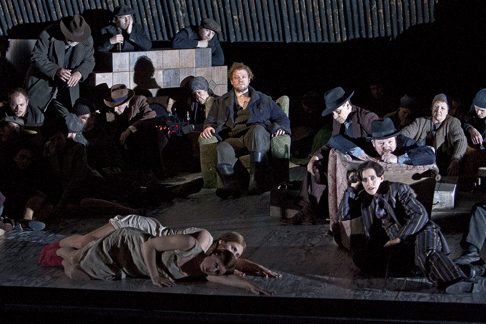In one of the production’s
creepiest moments, the big man-hunt chorus in the middle of Act 3 is
accompanied by waving of miniature Union Jacks.
Everyone you focus on has a darker secret than the last. At the more normal
end of the range are Felicity Palmer’s Miss Marple-esque Mrs Sedley and
Leigh Melrose’s apparently speed-addicted Ned Keene. The most disturbing
include Darren Jeffery’s Hobson, who appears to have a whole boy-killing
factory of his own going on unnoticed right under everybody else’s noses.
Weirdest of all are Auntie and the Nieces — Rebecca de Pont Davies as a
club-footed cross-dresser with a pinstripe suit and walking cane, and Mairéad
Buicke and Gillian Ramm as a pair of possessed zombie twins in identical school
uniform and pigtails. The Nieces are the production’s only faintly
jarring note, with their vacant and jerky choreography which makes them barely
even recognisable as human beings, but if they have one dramatic function
it’s giving a new layer of depravity to Bob Boles, Swallow and everybody
else who shows a sexual interest in them. Perhaps they are the ultimate product
of this diseased community.
Yes, it’s the norm here to be disturbed, deformed or damaged (even
Balstrode, sung by the excellent Gerald Finley, is missing an arm —
besides the costumes, this is the most obvious visual clue to the
production’s 1940s setting, though Auntie seems a throwback to the 30s)
and Peter and Ellen are seemingly the only complete and sane individuals among
them. Although her even-temperedness and common sense make her stand out from
her neighbours, Ellen is integrated into the community — a community
where people do everything together, moving in swarms — but Grimes is a
loner, and it is this and this alone which leads to his becoming the local
scapegoat. By the end, they have poisoned him into madness, but at least he is
able to escape through death. Ellen is the one who has to live with it all, and
I dare say she fits right in with the rest of them after all she has been
through. With Amanda Roocroft in the role, there are echoes of her recent,
brilliant Jenufa here — a bright-natured, attractive young woman worn
down through her experiences. At times her singing is shrill on top and her
diction indifferent, but her character portrait is spot on, the relationship
with Grimes filled with real tenderness.
The Australian tenor Stuart Skelton is as fine a Grimes as you could wish to
hear, wielding both his large voice and burly physique with intelligence and
subtlety. Emerging from the man-hunt and the subsequent pained calm of the
final interlude, Alden’s staging of the mad scene is devastating in its
simplicity: the surtitle screen and orchestra pit go dark, and Grimes is alone
in the abyss beneath a grey and foggy sky. Skelton maximises the effect the
solitude of the setting with a performance of heartbreaking vulnerability and
emotional intensity.
 Peter Grimes (Stuart Skelton); Auntie (Rebecca de Pont Davies) (front rt); Bob Boles (Michael Colvin) (front rt in upturned chair); First Niece (Gillian Ramm) (lying down front nearest); Second Niece (Mairéad Buicke) (behind first neice)
Peter Grimes (Stuart Skelton); Auntie (Rebecca de Pont Davies) (front rt); Bob Boles (Michael Colvin) (front rt in upturned chair); First Niece (Gillian Ramm) (lying down front nearest); Second Niece (Mairéad Buicke) (behind first neice)
As Grimes hears the drum-led procession approaching his hut — in a
clear and chilling musical echo of his vision, moments earlier, of the first
dead boy — he is distracted into letting go of the rope with which he is
making safe John’s descent down the cliff. Thus the villagers become
directly responsible both for the death of the apprentice and for Peter’s
self-destruction as a result of it. It is a heart-stopping coup-de-theatre.
In the two years that Ed Gardner has been ENO’s Musical Director I
don’t think he has ever drawn a better performance from the house
orchestra than in this detailed but never fussy account of the score. The
playing of the interludes was virtually faultless, with a particularly
memorable brass timbre, the jazzy shape of the phrases in the Storm Interlude
crafted so as to introduce the incongruous 1930s vintage of the inhabitants of
the Boar. A number of remarkable and inventive Grimes stagings have been seen
in London this decade, but musically, this is head and shoulders above the
others. It is perhaps ENO’s finest musical achievement this decade.
Ruth Elleson © 2009

